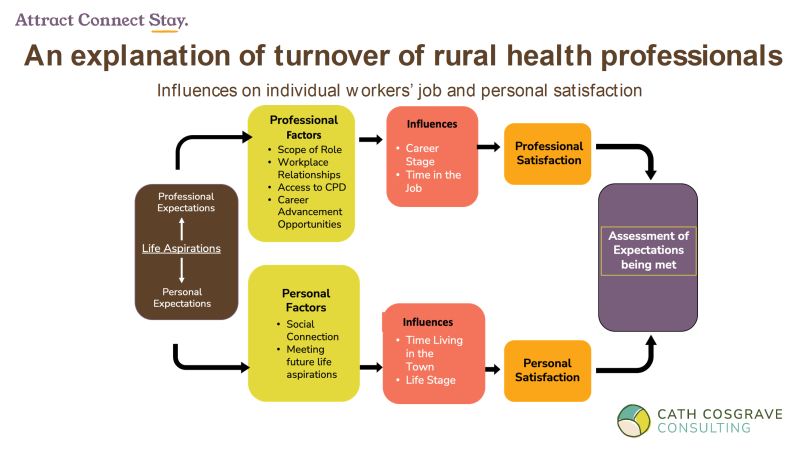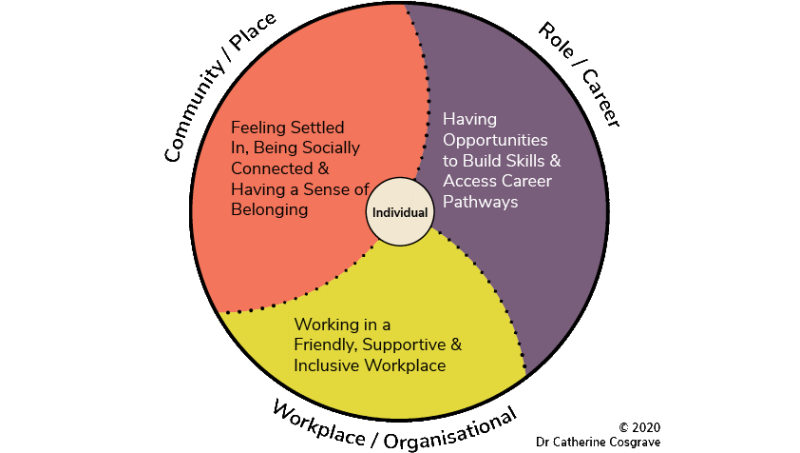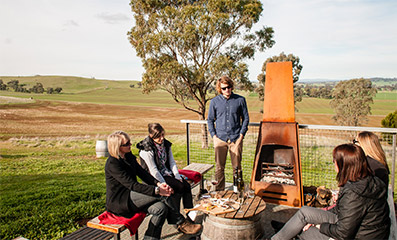The Greater Shepparton region is having a huge surge in job opportunities and there are many ‘hard to fill’ positions where we need to attract skilled professionals from outside Greater Shepparton – both across Australia and overseas.
To address this challenge, in 2019 an Attraction, Recruitment and Retention Strategy was Id from a collaboration between Greater Shepparton City Council, the Ie for Greater Shepparton and Goulburn Valley Health.
This strategy was underpinned by Dr Cath Cosgrave’s rural health workforce strengthening research and in particular her Whole-of-Person Retention Improvement Framework (discussed below).
Dr Cath Cosgrave has 25+ years’ experience working with rural communities developing person-centred, strengths-based strategies to effectively address workforce shortage issues in local health and community services.
Dr Cosgrave’s doctoral research study was an investigation of the factors impacting the turnover intention of rural-based public sector allied health and nursing professionals, she found that individual health professionals’ decisions to stay or leave their rural position was determined by the extent of the gap between an individual’s personal and professional expectations and their current job and rural living ie. She used satisfaction levels to express the extent to an individual’s professional (having job and career factors) and personal expectations were being met.
The factors Dr Cosgrave found to influence professional satisfaction most strongly were the scope of the role; the quality of workplace relationships; the extent of access to continuing professional development; and career advancement opportunities. Professional satisfaction levels were also found to be strongly affected by the time in the job. While all participants Ied a difficult initial adjustment upon starting work in a rural place, the duration and severity was found to be affected by the extent of professional experience, with ‘early career-beginners’ (those with three years or less work Ie) having the hardest and longest transition—between 12 months and two years.
Factors influencing personal satisfaction were an individual’s sense of belonging towards the place they live and work in and their assessment of that place’s ability to meet their (and any other family member’s) future life aspirations. Not surprisingly, significant differences were found in levels of personal satisfaction between ‘locals’ and ‘newcomers. While locals commonly expressed feeling a strong sense of belonging, newcomers described feelings of alienation and social disconnection, especially In the first 12 months of moving to a rural town but over time reported that their sense of belonging- increased. These findings are diagrammatically summarised below.
In addition, Dr Cosgrave’s research found that for a rural or regional community to achieve a ‘sustainable’, ‘fit-for-purpose’ skilled professional workforce — attraction and retention strategies must be tailored for the particular social and geographic context (i.e. be place-based) as well as actively involve residents in the planning and delivery of strategies (community engagement).
This emphasis on place-based and community engagement is based on the fact that every place is unique, and place-specific realities must be understood and integrated into the planning and implementation of any workforce strengthening strategies to be successful.
Creation of a person-centred holistic framework for strengthening a rural professional workforce
Over the last ten years Dr Cosgrave has conducted hundreds of interviews with rural-based skilled professionals about their Ie working in a professional role and living rurally, Dr Cosgrave has distilled these learnings into a framework.
The framework is aimed at tackling long-standing shortages of skilled professional workforce in rural and regional communities. Dr Cosgrave has named it the ‘Whole-of-Person Retention Improvement Framework’.
While the framework’s focus is on retention, it does not ignore attraction or recruitment. Rather, they are embedded within the framework, as to have a high chance of retaining staff it is first essential to attract a strong pool of ideal candidates and then recruit for ‘best-fit’ for the job, team, organisation and community.
The framework recognises and embraces the need for a whole-of-community response and address identified challenges for skilled professionals at the individual, organisational and community levels.
WoP-RIF identifies three key domains that are known to impact the retention of skilled professionals:
- Workplace / Organisational,
- Role / Career, and
- Community / Place.
Each domain identifies the pre-conditions needed to strengthen skilled professionals’ job and personal satisfaction (see Table 1).
| Types of Satisfactions | WoP-RIF domains | Major influences on job/personal satisfaction |
|---|---|---|
| Professional satisfaction | Workplace | High quality workplace relationships with line manager and team |
| Organisational | Business managed efficiently and strategically | |
| Role | Opportunities to engage with skilled professionals in the same field | |
| Career | Opportunities within the business and locally for career development and advancement | |
| Personal satisfaction | Place | Feel sense of belonging in place |
| Community | Community participates in the planning and implementation of attraction and retention strategies |
A distinguishing aspect of WoP-RIF, compared to other rural professional workforce retention frameworks/models, is the equal weighting given to the ‘Community and Place’ as to the Workplace/Organisational and Role/Career domains.
While the ‘Community and Place’ domain has relevance for all skilled professionals, it is of particular importance to those professionals who move to a rural place to take up a position.
Dr Cosgrave’s research identifies if ‘newcomers’ do not settle-well or develop strong social bonds within the first 12-months of relocating, then turnover is likely.
The WOP-RIF has been described as a ‘valuable resource’ for rural communities to use both independently in their organisations/businesses and jointly as a community to address long-standing workforce shortages of skilled professionals.
The Greater Shepparton Community Connector Program (CCP) is a workforce strengthening strategy operationalising the community and place domain of WoP-RIF. The CCP is based on a model created by a community in a small rural town in Canada in response to a crisis in health professionals. Dr Cosgrave came across the model during her 2018 Churchill Fellowship.
Greater Shepparton is the first community in Australia to implement the Community Connector model from Canada and continues to lead the way for other rural communities wanting to establish a similar program – Dr Cath Cosgrave.
In the first 18-months of operating, the Greater Shepparton Community Connector Program has been tremendously successful, supporting 300 newcomer skilled professionals (and their families) to settle into the region and make social connections. As the program has matured, the CCP team program is now also supporting local businesses to develop effective attraction and recruitment campaigns.











